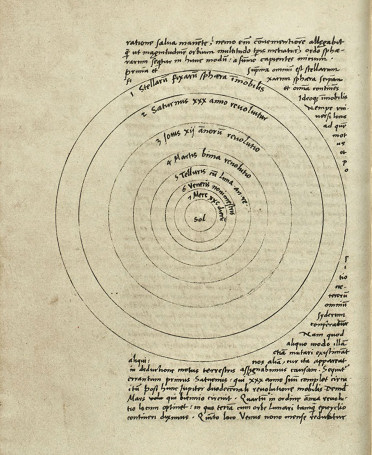
The nature of Copernicus discoveries
 It was not astronomical observations, even the most accurate ones, that
were the basis of Copernicus astronomy, but contemplation of the harmony
of the universe. While analysing geocentric astronomy, Copernicus found
that it describes the construction of the world with a fairly random set
of hypotheses.
He showed great respect for
the craft of the finest representatives of ancient astronomy, but at the
It was not astronomical observations, even the most accurate ones, that
were the basis of Copernicus astronomy, but contemplation of the harmony
of the universe. While analysing geocentric astronomy, Copernicus found
that it describes the construction of the world with a fairly random set
of hypotheses.
He showed great respect for
the craft of the finest representatives of ancient astronomy, but at the
 same time he wrote about them in his dedicatory letter in De revolutionibus
in a following way: ...their experience was just like some one taking
from various places hands, feet, a head, and other pieces, very well depicted,
it may be, but not for the representation of a single person; since these
fragments would not belong to one another at all, a monster rather than
a man would be put together from them (translated by Edward Rosen). Copernicus
searched for the simplest solutions, which in an irresistibly logical and
harmonious way would explain all the observed motions of planets. Eventually,
he reached the conclusion that this condition is met by the system the
centre of which is the Sun, whereas the planets revolve around it in the
order, which is determined by the speed of their motions: from the fastest,
Mercury, through Venus, Earth, Mars, Jupiter, to the slowest one, Saturn.
In Copernicuss universe beyond the Solar System only stars could be found,
which, because of Copernicuss assumption of Earths daily rotation around
its own axis, could remain still. Thus, the most important discovery of
Copernicus consisted in understanding that the world order was devised
in the form of the heliocentric system, in which Earth is one of the planets,
that is one of the centres of gravity, and the distant stars do not have
to rotate around it at the dizzying speed of one rotation per 24 hours.
The rest was boiled down to such use of mathematics and observations as
would grasp this order as precisely as possible, in order to determine
the construction of planetary orbits, their size and position in space
- a matter requiring a perfect knowledge of geometry and many hours spent
under the open sky, as well as time consuming calculations, but still of
secondary importance.
same time he wrote about them in his dedicatory letter in De revolutionibus
in a following way: ...their experience was just like some one taking
from various places hands, feet, a head, and other pieces, very well depicted,
it may be, but not for the representation of a single person; since these
fragments would not belong to one another at all, a monster rather than
a man would be put together from them (translated by Edward Rosen). Copernicus
searched for the simplest solutions, which in an irresistibly logical and
harmonious way would explain all the observed motions of planets. Eventually,
he reached the conclusion that this condition is met by the system the
centre of which is the Sun, whereas the planets revolve around it in the
order, which is determined by the speed of their motions: from the fastest,
Mercury, through Venus, Earth, Mars, Jupiter, to the slowest one, Saturn.
In Copernicuss universe beyond the Solar System only stars could be found,
which, because of Copernicuss assumption of Earths daily rotation around
its own axis, could remain still. Thus, the most important discovery of
Copernicus consisted in understanding that the world order was devised
in the form of the heliocentric system, in which Earth is one of the planets,
that is one of the centres of gravity, and the distant stars do not have
to rotate around it at the dizzying speed of one rotation per 24 hours.
The rest was boiled down to such use of mathematics and observations as
would grasp this order as precisely as possible, in order to determine
the construction of planetary orbits, their size and position in space
- a matter requiring a perfect knowledge of geometry and many hours spent
under the open sky, as well as time consuming calculations, but still of
secondary importance.
Institute for the History of Science
Polish Academy of Sciences
Further reading:
- J. Dobrzycki, The Role of Observations in the Work of Copernicus, Vistas in Astronomy, Vol. 17 (1975), 27-30.
- J. Dobrzycki, Notes on Copernicuss Early Heliocentrism, Journal for the History of Astronomy, Vol. 32 (2001), 223-5.
- O. Gingerich, The Astronomy and Cosmology of Copernicus, Highlights in Astronomy of the International Astronomical Union, ed. by G. Contopoulos, Vol. 3 (1974), 67-85.
- O. Gingerich, Crisis versus Aesthetic in the Copernican Revolution, Vistas in Astronomy, ed. by A. Beer and K. Strand, Vol. 17 (1975), 85-95.
- A. Goddu, Reflections on the Origin of Copernicuss Cosmology, Journal for the History of Astronomy, Vol. 37 (2006), 37-53.